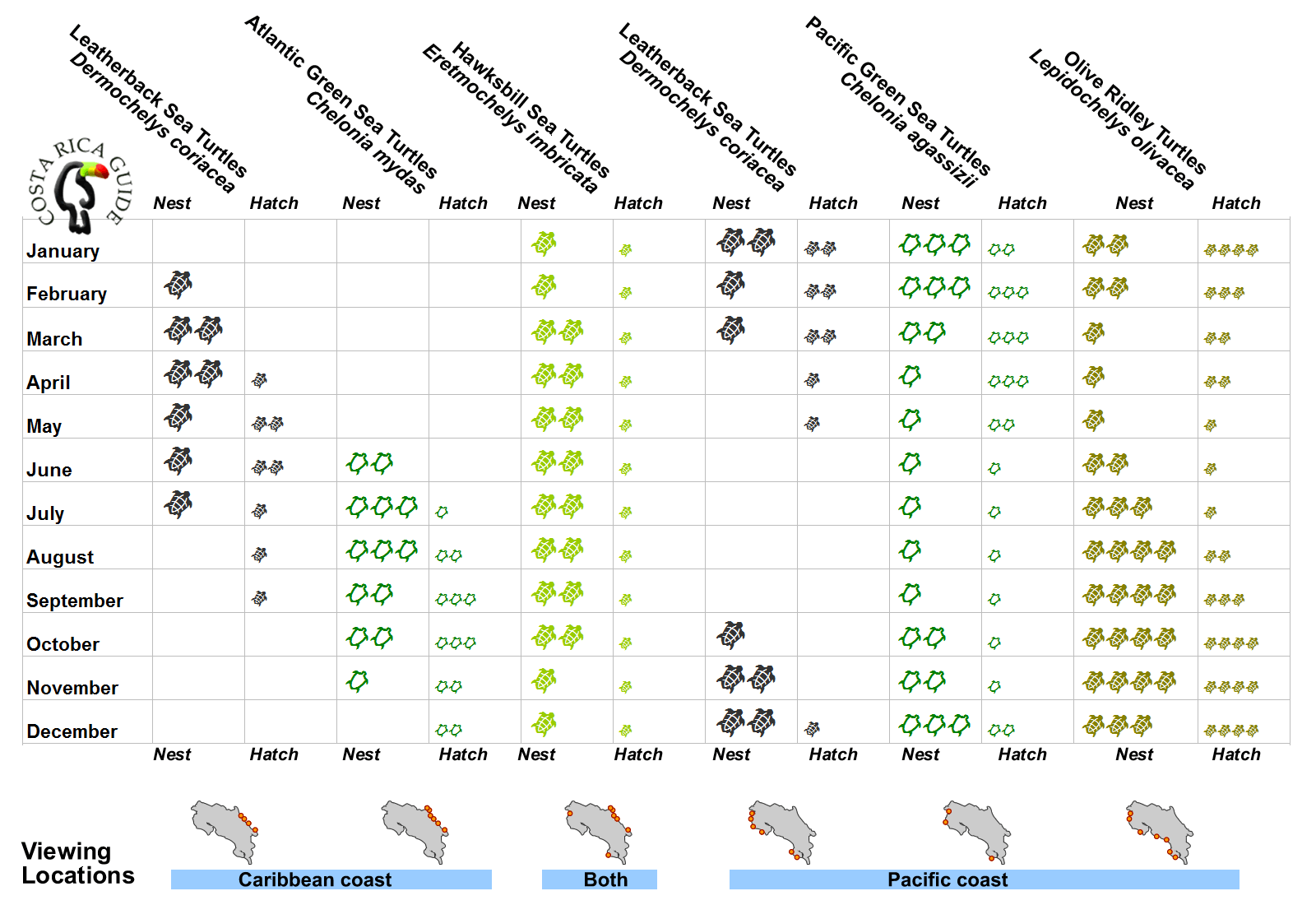Playa Grande FAQ
We know you must have tons of questions about visiting Playa Grande, which is why we’ve made this awesome, easy to use FAQ just for you! Our information is frequently reviewed and updated so there won’t be any surprises once you get here. Happy reading!
Playa Grande sits along the Pacific Ocean at the top of the Nicoya Peninsula in the northwest corner of Costa Rica.
At 10 degrees latitude, Playa Grande is smack in the middle of the tropics. The water and temperature are warm to hot all year long, both averaging in the 80s for the year. Playa Grande is just north of the estuary from Tamarindo. Whereas Tamarindo is known for its lively nightlife, Playa Grande is much more low key.
The town of Playa Grande is located within Las Baulas National Park. Name for the leatherback sea turtles nesting on this beach for eons, Las Baulas has been established to preserve this rare habitat. From nesting to hatching, turtle season lasts from October to March. Out of courtesy for the turtles, visitors are not permitted on the beach from 6:00 pm until 6:00 am during turtle season. The only exception is the official tours given by the MINAE. For more information see our turtle tours page. Las Baulas National Park also spans into the The estuary, where visitors can take guided tours to see caiman, monkeys, green parrots, and other exotic wildlife.
The weather here in Playa Grande is commonly split into two categories: dry season and rainy season. The name “dry season” says it all. It doesn’t rain. Period. From some time in November until late April, mid May, the faucet in the sky is shut off, and it’s nothing but pure sunshine in Playa Grande.
Rainy season, which lasts the other part of the year is a bit more complicated. From May to October there is at least a possibility of rain, but some months are rainier than others. May, June, July, and August are referred to as “green season” around here. The cooler temperatures are welcomed from hot days in April, though it must rain some to bring the temperatures down and turn our dry forest into a tropical landscape.
The true rainy season lasts between September and October. Though we may have some occasional clear days, this time of year produces ideal condition under the sea. Divers looking for a low-key getaway can get great rates on hotels and rental cars during these months.
When it comes to packing for your Costa Rica vacation, the places you go and activities dictate what goes on your suitcase. If you’re planning on stay a week in Playa Grande, might we suggest our handy Packing for Playa Grande page.
If you’re going to be visiting other parts of the country, be sure to find out the appropriate clothes. The cloud forests in Arenal and Monteverde are much cooler, so travelers may want to pack jeans and a light jacket. Even San Jose can dip as low as the 50s on the coolest of nights.
The official currency in Costa Rica is the colon, it’s approximately 500 colones to $1USD, but it can fluctuate between 490 and 505 on any given day. Dollars accepted everywhere in Playa Grande as well as colones. Most businesses accept credit cards, but be prepared to pay higher rates due to international charges. While we’re thinking about it, remember to contact your credit and debit card providers to let them know you are out of the country or they might freeze your account.
Scotia has recently added an ATM in the Super Compro in Huacas. There is also one located in Automercado coming into Tamarindo, and several others at local banks such as Banco Costa Rica and Banco Nacional in Conchal Plaza in Tamarindo. There is also a BCR on the way in to Playa Flamingo. All ATMs have Spanish/English options and give dollars or colones. Check with your banks to see what type of international fees apply before using your debit card in Costa Rica.
Cell phone service has grown by leaps and bounds over the last few years, and there are a few ways to acquire mobile service in Costa Rica. If you do not wish to use your own phone, many rental car agencies, like Adobe, will lend you a phone for a few bucks a week. Rental phones are typically Nokias circa 1997, so there are only talk and text capabilities. This option is perfect for families and groups that will be splitting up for outings.
The more tech savvy person can bring in a GSM phone. Phones must be unlocked (not simply jailbroken) in order to be used here in Costa Rica and on the following GSM bands:
850, 1800, 2100 (verified August, 2016)
You can purchase KOLBI or MovieStar prepaid SIM cards at grocery stores for a few thousand colones; this amount should last you the entire vacation.
Should you be bringing a smartphone and you have no intentions of using Costa Rica cell service, be sure to put your phone on Airplane Mode before you leave the airport to avoid international roaming charges.
Playa Grande’s turtle season lasts between October and March. Leatherbacks and Olive Ridleys begin their nesting at the height of the rainy season. Since the leatherback’s average incubation period is 60 days, the first turtles hatch in December. During turtle season, Playa Grande guests are not allowed on the beach from 6:00 pm to 6:00 am—with one exception of course.
The MINAE offers an official turtle tour. For $25USD per person, the MINAE will take you on a turtle watching expedition. For more information, check out our turtle tour page.
It’s almost always a good time to surf in Playa Grande. The waves here are known more for their consistency, than their size. We recommend checking out the surfing page for more info. Also, take a peak at our live surf cam complete with a daily surf report.
In addition to playing at the beach, Playa Grande has several activities that can be enjoyed by kids of all ages. The estuary excursion and Palo Verde are both great riverboat tours for young children. Ziplining and the Rincon de la Vieja Adventure are great for thrill seekers. Frijoles Locos offers surf lesson to kids as young as 3 to 4 provided they are solid swimmers.
Costa Rica is home to two international airports: the Juan Santamaria (SJO) near the capital of San Jose, and Daniel Oduber (LIR) in Liberia. While SJO is over 250km away from Playa Grande, fares are often cheaper, but you will have to take ground transportation and a domestic flight the rest of the way. Liberia is just an hour away, yet tickets can often be more expensive. Tamarindo also has its own airstrip for domestic flights. For more information, see our air travel entry.
Whether you’re flying into SJO or LIR, there are several ground transportation options. Grayline and Interbus travel all throughout the country and have shuttles twice a day to the most popular tourist destinations. Tickets cost approximately $45USD each way. Ask your hotel or house concierge about shuttle recommendations. You can also hire a private shuttle from the airport or to take you to and from national parks, fishing trips, and other outdoor adventures.
Before departing from Costa Rica via LIR or SJO, all visitors are required to pay a Departure Tax. Currently the fee is $29USD per person. You will need to pay the cashier at the airport before checking in with your airline. Be ready with payment and your passport. You are strongly encouraged to pay with cash. There are debit fees associated with using your card, and credit cards are charged as a cash advance. Have a pen handy since you’ll need to fill out some of the paperwork on the tax sheet and hand it into the airline.
Departure tax cost last confirmed August, 2013.
One question most visitors ask is whether or not they need a car during their stay in Playa Grande. The answer is wholly dependent on your own needs. While a car isn’t necessary, renting one is strongly encouraged, especially a 4WD vehicle if you’re staying in Palm Beach Estates during green season.
Cars are great for exploring the area, and are almost essential for grocery store runs. However, if you’re staying in a hotel, you’re within walking distance of excellent food, and groceries may not be a concern.
Costa Rica has mandatory insurance requirements and often when people reserve cars, the quote does not include insurance. If you book your car through a US based company, prices often doubles upon arrival. Ask hotels and house concierges if they can make arrangements since they typically know the most reputable agencies that give an honest estimate.
The alternative to not having a car is renting bikes from Frijoles Locos or hiring a private shuttle to get you other places.
It used to be the case that the entire bay area had to drive back through Huacas and up the mountain to El Llano—over 20km away—to get gas. In early 2013, a new service station opened up on the road towards Tamarindo. Make a right in Huacas coming from Playa Grande and it’s on the left a few kilometers up the road. Gas stations are open 24 hours in Costa Rica, and they accept colones, dollars, and plastic.






Get Social